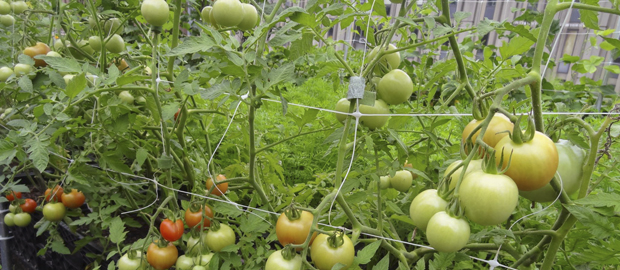How will climate change impact New England’s food security?
Why finding ways to produce more local food needs to be a priority for New England as the climate warms.
 Photo/Julian Cardillo '14
Photo/Julian Cardillo '14Brandeis environmental studies professor Brian Donahue – an expert in forestry and farming – has a plan to help New England produce half its food by 2060, even with the negative impact of continuous global warming.
In a document he co-authored called “A New England Food Vision,” Donahue, a farmer himself, calculated the potential of converting a small part of New England’s forests into cropland and pasture. The analysis, first released in 2014, was based on healthier diets with less meat and more fruits and vegetables.
The vision takes into account a number of variables – increases in population, food justice, health costs, and, perhaps most intriguing, climate change.
BrandeisNOW sat down with Donahue to discuss how his vision deals with producing more food as New England warms and goes through more droughts and extreme events such as what the region has experienced this summer.
BNOW: In the New England Food Vision, you talk about repurposing some forestry for cropland and pastures. How does climate change affect that vision?
Brian Donahue: Climate change will both stimulate and challenge regional food production. The New England Food Vision isn’t a set plan—it is extremely adaptable. It indicates broad areas where our region could move in terms of producing more food. But first, we stress the need to protect most of our forest.
The forest, just by being there, sequesters carbon and reduces our footprint. Forests are also great buffers against flooding and protect water quality. So we can’t talk about the food vision without the forest framework. But, some forest could safely be repurposed for farmland.
Our biggest change would be moving to grass-based dairy and beef, reducing our reliance on purchased feed grain by providing several million acres of pasture within the region. That’s a big change to the landscape.
New England currently produces about half its dairy, which we’d increase to all. Increased pasture means a considerably lower energy input for milk and beef, and would make the land more able to absorb large rainstorms.
BNOW: Are there any benefits from the climate getting warmer?
BD: Well, climate change will shift regional advantages all around the world, and make some forms of local production more competitive. The warming climate makes the New England growing season longer, which means we can produce more fruits and vegetables. Also, we don’t have to feed cows in the barn as much as we used to, which is an advantage. We’re able to extend the grazing season and don’t have to buy as much feed, and instead of cutting hay, we can have cows out eating grass longer, which also lowers input costs.
Conceivably, some fruits like peaches, apricots and grapes that were previously difficult to grow in our climate could expand.
On the downside, there will likely be more extreme weather events, and that will be challenging. But it’s not like a whirlwind will just come and sweep everything away. We need a diversified, resilient approach.
BNOW: Soclimate change can also bring about some potentially scary scenarios, right?
BD: Right, it’s not all roses. We will get more kinds of pests, which we’re already seeing. Over the last few years we’ve seen more late blight in potatoes and tomatoes. Even organic farmers can handle these issues with various pesticides, but doing so is expensive and should always be a last resort. You can do something through natural controls and improving the health of the soil so plants are more resistant, but more pests is still a big problem.
Most studies already predict that, with climate change the price of food around the world will go up, maybe considerably. Where things grow will likely shift around. A lot of places won’t get the water they used to. Like the Central Valley of California, which currently produces most of our fruits and vegetables.
We have a world population that’s on the rise and more people are demanding richer diets. It will be an enormous challenge to produce all that food, and in general climate change won’t help. Every place will want to become more diversified and resilient.
BNOW: As climate change continues, how much will we need to rely on local food?
BD: We estimate New England could conceivably grow about half of its own food—maybe a little more in dire straits. Some stuff we will always want to bring in, because we are not capable of growing it here. We can’t grow coffee and oranges, for example. And we can’t grow nearly enough grain, which is an easy thing to ship. But you don’t really want a world in which everyone only lives off of local food – that would be a dangerous world.
People used to eat locally, after all, and as a result were often victims of local famine. With droughts like the one we had this summer, pastures dry up. Crops fail. So having both local and global food sources is important in terms of resilience.
Too much reliance on a global food market has created a brittle system that makes it prudent to look at more local sourcing, but there is still something to be said for being part of a bigger structure. We have farmers here in New England who are developing new markets and are already reacting to the changes they see year to year. They’re trying things out to deal with climate changes, which is what we want to see.
Maintaining our forests and diversifying our farming will increase our resilience to adapt to what climate change brings.
Categories: General, Research, Science and Technology





